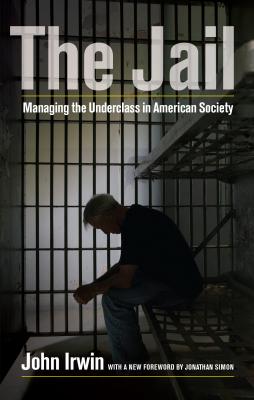ТОП просматриваемых книг сайта:
The Jail. John Irwin
Читать онлайн.Название The Jail
Год выпуска 0
isbn 9780520957459
Автор произведения John Irwin
Жанр Юриспруденция, право
Издательство Ingram
The Jail
THE JAIL
MANAGING
THE UNDERCLASS
IN AMERICAN
SOCIETY
John Irwin
With a New Foreword by
Jonathan Simon
UNIVERSITY OF CALIFORNIA PRESS
BerkeleyLos AngelesLondon
University of California Press, one of the most distinguished university presses in the United States, enriches lives around the world by advancing scholarship in the humanities, social sciences, and natural sciences. Its activities are supported by the UC Press Foundation and by philanthropic contributions from individuals and institutions. For more information, visit www.ucpress.edu.
University of California Press
Berkeley and Los Angeles, California
University of California Press, Ltd.
London, England
First paperback printing 1987
© 1985, 2013 by The Regents of the University of California
ISBN 978-0-520-27734-2
eISBN 9780520957459
The Library of Congress has cataloged an earlier edition of this book as follows:
Library of Congress Cataloging-in-Publication Data
Irwin, John.
The jail : managing the underclass in American society.
Bibliography: p.
Includes index.
ISBN 978-0-520-06032-6 (pbk. : alk. paper)
1. Jails—Social aspects—California—Case studies.2. Prisoners—California—Case studies.3. Prison psychology.I. Title.
HV8324.I791986
365’.6’0979461
85–1155
Manufactured in the United States of America
22 21 20 19 18 17 16 15 14 13
10 9 8 7 6 5 4 3 2 1
In keeping with a commitment to support environmentally responsible and sustainable printing practices, UC Press has printed this book on Natures Natural, a fiber that contains 30% post-consumer waste and meets the minimum requirements of ANSI/NISO Z39.48-1992 (R 1997) (Permanence of Paper).
To Erving Goffman, who tried to teach me, but I wouldn’t learn
Contents
List of Tables
Foreword
Preface
Acknowledgments
1Managing Rabble
2Who Is Arrested?
3Disintegration
4Disorientation
5Degradation
6Preparation
7Rabble, Crime, and the Jail
Appendix
Notes
Bibliography
Index
Tables
1.Distribution of Charges in the Felony Sample (100 arrests)
2.Distribution of Charges in the Misdemeanor Sample (100 arrests)
4.Relationship Between Crime Seriousness and Offensiveness
5.Relationship Between Offensiveness and Seriousness of Crime Among Arrestees Held over Ten Days in Jail
Foreword
John K. Irwin was the leading social scientist of the American carceral enterprise from the middle of the twentieth century through the first decade of the twenty-first (and the most successful former prisoner in American social science in the same period). Each of Irwin’s five books on American incarceration is a superb study of distinct topics in the scholarly study of punishment, law, and society; for example, the status hierarchy among American convicts at mid-century in The Felon (1970), or the impact of civil rights on the racial order of prisons during the 1960s and 1970s in Prisons in Turmoil (1980). Cumulatively they document the changing nature of American carceral practices from the postwar medical model, with its large rehabilitative promises and relatively small prison populations, through mass incarceration from the late 1970s on, with its seemingly modest promises to confine (or warehouse) prisoners and its supersize prison populations.
Nearly thirty years after its initial publication, John Irwin’s Jail: Managing the Underclass in American Society (1985) stands out for three reasons that make this reprinting particularly timely.
1 In Jail, Irwin identifies the underclass—an emerging social category of young, minority urban residents isolated from the social mainstream both by persistent unemployment and by a subjective sense of alienation from the labor market and its normative order—as a primary concern for the criminal justice system in general and jails in particular. Today the emergence of this kind of hardened urban marginality, and the political choice to rely on law enforcement as a primary form of governance over such economically marginal populations, is viewed as one of the primary causes of mass incarceration (Wacquant 2009).
2 Irwin argues that the major role of jails with respect to the underclass (or rabble, as he provocatively calls this class as a target of state coercion) is not to enforce laws or punish crimes but to govern a population of extreme marginality, a “precariat” living in a zone of permanent uncertainty as to basic life needs. Today the idea that the criminal justice system is primarily a way to manage risk rather than do justice is widely if cynically accepted (Feeley and Simon 1992).
3 At a time when attention was beginning to turn to the rapid increase of prisons and prisoners, the dawn of mass incarceration, Irwin identified jails as an enduring part of the modern carceral state and not an archaic survivor of the common-law past. While many of us who have worked to make sense of mass incarceration followed Irwin’s lead in considering the production and maintenance of the underclass, few, if any, took his hint to keep our eye on jails. Today, as many states seek to tame their overextended prison systems by channeling felony offenders and technical parole violators toward jails, the features of the jail that Irwin identified—its low visibility, discretionary decisions by low-level justice officials, and cruel conditions—raise troubling questions about the use of this strategy, which California governor Jerry Brown and others have dubbed “realignment,” in attempting to provide a productive solution to the crisis of mass incarceration.
As Irwin recognized, jails have long operated as a shadowy margin to our celebrated institutions of what Max Weber famously called “legal rational authority,” particularly the court and the prison. To the courts, jails function as depositories, holding those charged with crimes who have not been able to secure pretrial release (generally through bail) until the disposition of their case by trial or plea, and as threats to those who have been granted release. Against the prison, the jail has either been a preliminary stage of custody prior to incarceration in state prison or a parallel system of carceral punishment lacking many of the correctional programs and legal protections available to prisoners in modern

